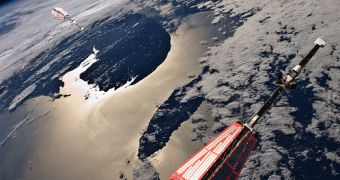A constellation made up of three satellites has just passed its final tests, and is now ready for a planned July launch. The mission, called Swarm, consists of a trio of spacecraft designed specifically to study Earth's magnetic fields.
Developed by the European Space Agency (ESA), the probes will be launched aboard a Russian satellite from either the Plesetsk or Baikonur Cosmodromes. Both are operated by the Russian Federal Space Agency (RosCosmos), on in Russia and the other one in Kazakhstan.
ESA officials conducted a press conference yesterday, February 17, presenting the three satellites to the media inside a cleanroom. They represent the fourth Earth Explorer mission to be deployed in orbit, alongside SMOS, CryoSat and GOCE.
SMOS is the Soil Moisture and Ocean Salinity satellite. CryoSat is responsible for analyzing the thickness and motions of polar ice caps. GOCE is the Gravity Field and Steady-State Ocean Circulation Explorer spacecraft. Its role is to compile a map of Earth's gravitational field.
The Europeans want to build a network of Earth observatories capable of keeping track of multiple planetary traits at the same time. The Swarm mission will help do that by monitoring the magnetic field and the processes going on within.
“Swarm is the next mission in our Earth Observation Envelope Program. We expect the innovative Swarm constellation of three satellites orbiting in formation to deliver the best-ever survey of Earth’s magnetic field,” explains the ESA Director of Earth Observation Programs, Volker Liebig.
One of the constellation's main jobs is to measure the magnetic signals released by the Earth's mantle, core and crust, the planet's oceans and ionosphere, as well as its magnetosphere. The end goal is to understand how interplays occurring between these sources keep our planet safe from radiations.
The Sun is constantly releasing radiations that would otherwise harm us extensively. Cosmic rays are permeating the solar system at all times, and they, too, are very dangerous if not stopped.
“This shield is generated mainly deep inside Earth by an ocean of swirling iron in the liquid outer core. How the magnetic field is created and how it changes over time is complex and not fully understood,” ESA experts explain in a press release.
“But with a new generation of sensors, the Swarm constellation will provide greater insight into these,” they conclude.

 14 DAY TRIAL //
14 DAY TRIAL //